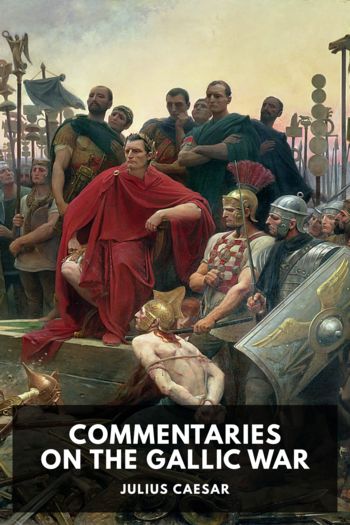Fateful Lightning: A New History of the Civil War & Reconstruction by Allen Guelzo (icecream ebook reader txt) 📗

- Author: Allen Guelzo
Book online «Fateful Lightning: A New History of the Civil War & Reconstruction by Allen Guelzo (icecream ebook reader txt) 📗». Author Allen Guelzo
ELEVEN. A DIM SHORE AHEAD
Specialized studies of the last six months of the war are rarer than for almost any other period of the Civil War. But certainly noteworthy among these for recounting the death agonies of the Army of Northern Virginia are William Marvel’s A Place Called Appomattox (Chapel Hill: University of North Carolina Press, 2000) and Lee’s Last Retreat: The Flight to Appomattox (Chapel Hill: University of North Carolina Press, 2002), along with Chris Calkins’s The Appomattox Campaign, March 29–April 9, 1865 (Lynchburg, VA: H. E. Howard, 1997), The Battles of Appomattox Station and Appomattox Court House, April 8–9, 1865 (Lynchburg, VA: H. E. Howard, 1987), and The Final Bivouac: The Surrender Parade at Appomattox and the Disbanding of the Armies (Lynchburg, VA: H. E. Howard, 1988). The assassination of Lincoln is quite another story, although much of the assassination literature is sensationalized storytelling. The standard account is still George S. Bryan’s The Great American Myth: The True Story of Lincoln’s Murder (Chicago: Americana House, 1990 [1940]), but Bryan has been considerably expanded by William Hanchett in The Lincoln Murder Conspiracies (Urbana: University of Illinois Press, 1986) and Edward Steers in Blood on the Moon: The Assassination of Abraham Lincoln (Lexington: University of Kentucky Press, 2001). Looking at the assassination from the assassin’s point of view requires Michael W. Kauffman’s American Brutus: John Wilkes Booth and the Lincoln Conspiracies (New York: Random House, 2005).
Reconstruction also enjoys a substantial and surprisingly colorful bibliographical history. William A. Dunning, in Reconstruction, Political and Economic, 1865–1877 (New York: Harper and Brothers, 1907), portrayed Reconstruction as a fanatical and utopian coup, launched by the Radical Republicans in violation of Lincoln’s intentions and carried out by a hungry swarm of political vultures known as carpetbaggers and their incompetent black allies. Dunning never lacked for critics among black historians, especially W. E. B. Du Bois and John Hope Franklin. But it was the publication of Kenneth Stampp’s The Era of Reconstruction, 1865–1877 (New York: Knopf, 1965) that decisively turned the “Dunning School” on its head. Stampp, influenced by the civil rights movement of the 1950s, sharply revised the reputation of Radicals and the carpetbaggers and placed the entire Reconstruction effort on the same high moral ground occupied by Martin Luther King Jr. Thirty years later, Stampp’s terse and comparatively short book is still in many ways the best introduction to Reconstruction. Stampp has enjoyed many followers, but none has towered so greatly above the rest as Eric Foner, whose Reconstruction: America’s Unfinished Revolution, 1863–1877 (New York: Harper and Row, 1988) expands Stampp’s focus to include wartime Reconstruction and other political and economic national developments. Yet a third departure from both Dunning and Stampp lies in Heather Cox Richardson’s treatment of Reconstruction as a conflict in political economy in The Death of Reconstruction: Race, Labor, and Politics in the Post–Civil War North, 1865–1901 (Cambridge, MA: Harvard University Press, 2001) and in her expansion of the scope of Reconstruction policies, in West from Appomattox: The Reconstruction of America After the Civil War (New Haven, CT: Yale University Press, 2007), to the western territories, which were, after all, the flash point of the controversies which provoked the War.
Andrew Johnson has attracted little favorable press, but he has enjoyed a number of able biographies. Albert Castel’s The Presidency of Andrew Johnson (Lawrence: University Press of Kansas, 1979) and Eric L. McKitrick’s highly critical Andrew Johnson and Reconstruction (Chicago: University of Chicago Press, 1960) both offer useful surveys of Johnson’s presidential policies, while Hans L. Trefousse’s Andrew Johnson: A Biography (New York: W. W. Norton, 1989) sets him clearly in the ideological world of the Democratic Party. Michael Les Benedict in The Impeachment and Trial of Andrew Johnson (New York: W. W. Norton, 1973) and David O. Stewart in Impeached: The Trial of President Andrew Johnson and the Fight for Lincoln’s Legacy (New York: Simon and Schuster, 2009) offer detailed accounts of the first presidential impeachment. The subsequent fate of Reconstruction in individual states has been treated in a growing list of local studies, including Joe Gray Taylor’s Louisiana Reconstructed, 1863–1877 (Baton Rouge: Louisiana State University Press, 1974), C. Peter Ripley’s Slaves and Freedmen in Civil War Louisiana (Baton Rouge: Louisiana State University Press, 1976), Joseph G. Dawson’s Army Generals and Reconstruction: Louisiana, 1862–1877 (Baton Rouge: Louisiana State University Press, 1982), Stephen V. Ash’s Middle Tennessee Society Transformed, 1860–1870: War and Peace in the Upper South (Knoxville: University of Tennessee Press, 1988) and When the Yankees Came: Conflict and Chaos in the Occupied South, 1861–1865 (Chapel Hill: University of North Carolina Press, 1995), Richard Zuczek’s State of Rebellion: Reconstruction in South Carolina (Columbia: University of South Carolina Press, 1996), Margaret M. Storey’s Loyalty and Loss: Alabama’s Unionists in the Civil War and Reconstruction (Baton Rouge: Louisiana State University Press, 2004), and Mark L. Bradley’s Bluecoats and Tar Heels: Soldiers and Civilians in Reconstruction North Carolina (Lexington: University Press of Kentucky, 2009).
A number of the participants in Reconstruction have earned their own biographies. Richard N. Current offers an elegant and determinedly revisionist collective biography of the major Southern Republicans in Those Terrible Carpetbaggers: A Reinterpretation (New York: Oxford University Press, 1988); Sarah Woolfolk Wiggins in The Scalawag in Alabama Politics, 1865–1881 (University: University of Alabama Press, 1977), and James A. Baggett in The Scalawags: Southern





Comments (0)